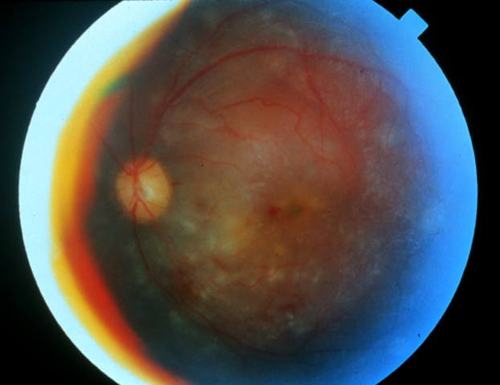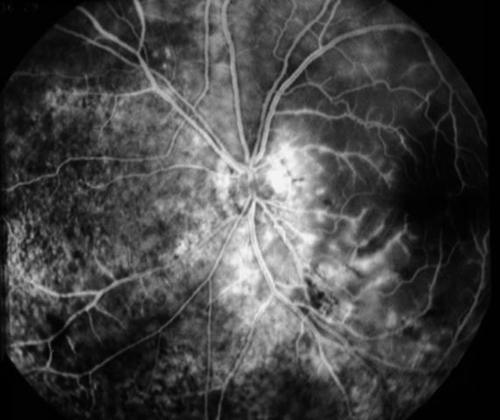Retina/Uveitis Quiz 3

Figure 1
This is the left fundus of a 25 year old woman who complains of photophobia and decreased vision of the left eye. There is 2+ cell in the anterior chamber and 2+ vitritis. She has a history of aseptic meningitis and a painful rash on her calf.
This is the left fundus of a 25 year old woman who complains of photophobia and decreased vision of the left eye. There is 2+ cell in the anterior chamber and 2+ vitritis. She has a history of aseptic meningitis and a painful rash on her calf.

Figure 2
Figures 2-3. These are the early and late fluoresceins of the above patient.
Figures 2-3. These are the early and late fluoresceins of the above patient.

Figure 3
Answer: A past or current history of oral apthous ulcers, genital ulcers, along with the patient's current anterior and posterior uveitis would be diagnostic of Behcet's disease. The classic triad of Behcet's disease consists of oral ulcers, genital ulcers and hypopyon uveitis. These photographs demonstrate extensive retinal vasculitis consistent with Behcet's disease. On examination the patient also had oral and genital ulcers.
2. What other non-ocular findings might the patient have?
Answer: Another common finding in Behcet's disease is skin lesions. These can vary FROM erythema nodosum to acneiform lesions. Behcet's patients typically display cutaneous hypersensitivity, a needle prick may elicit a pustule. This reaction is termed pathergy. Behcet's patients may also develop arthritis and vaso-occlusive events. Approximately, 15% of patients will have CNS involvement which may result in meningitis, seizures, or strokes.
3. What are the more common ocular findings in this disease?
Answer: The most common ocular findings are iridocyclitis with or without hypopyon, vitritis, and retinal vasculitis. Other less common ocular findings may include; conjunctivitis, keratitis, and scleritis. Vaso-occlusive disease may present with neuro-ophthalmic findings including extraocular muscle palsies and optic neuropathy.
4. What is the HLA association with this disease?
Answer: HLA B51 is 8-9 times more common in Behcet's patients than in those without the disease.
5. In which parts of the world is this disease most prevalent?
Answer: The disease is most prevalent in the Mediterranean and Far East, especially Japan.
6. What are the pathology characteristics of this disease?
Answer: The disease is a systemic vasculitis which affects both the arterial and venous circulations. Histopathology shows a perivascular infiltrate of lymphocytes, plasma cells, and surrounding tissue necrosis.
7. What is the natural history of this disease?
Answer: The ocular prognosis for this disease is very poor, without treatment up to 50% of patients are blind within 4 years of ocular manifestations. Mortality can occur with this disease especially when there is CNS involvement.
8. What are the treatments available for this disease?
Answer: Treatment often begins with coricosteroids, which temporarily quiets the disease, but appears to have no long term effect on the disease course. Other treatments include chemotherapeutic agents such as chlorambucil, cyclophosphamide, cyclosporine, and azathioprine. The use of these agents can result in substantial remissions. Colchicine is another option and is sometimes used in combination with other drugs.